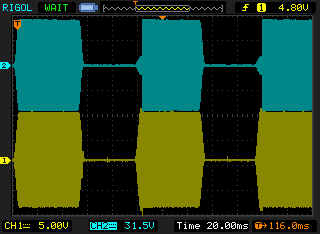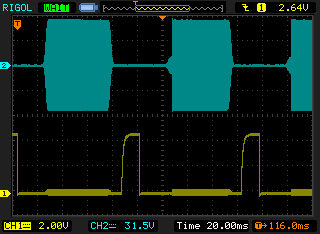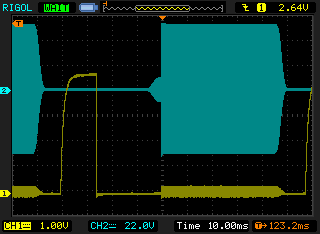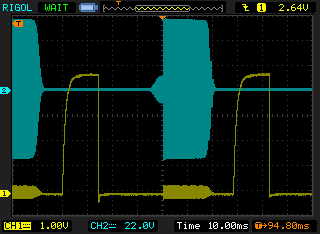
Looks good at 15WPM
This page isn't indexed, but on the off-chance someone stumbles upon it, I should point out that I prepared this in order to document a problem I found. I notified the designer of the HR-50 Amp, Jim Veatch, and within about five hours, he had responded, thanking me, and saying he thought the problem could be fixed by a firmware change. In about 24 hours, he sent me updated firmware which corrected the problem. After I responded that his updated indeed did fix the problem, he told me the fix would be in new shipping units, and the fix would be made available to customers of old units.
This was extraordinarily fast turnaround! Especially considering that this was a fairly minor problem with a very easy workaround.
The fix is in firmware version 3.0E and newer. The problem was discovered in firmware 3.0D.
The rest of this is just a historical document of the process of investigation.

It looks just as good up to 18WPM. But around 19 or 20 WPM, something bad starts to happen. It becomes very evident by 25WPM, as seen below.

Notice that the first dit has the same nice shape as above. But the second and third dits have poor output shape (cyan). You can see that the ramp is all at low power, as though the input is passing to the output unamplified, and then suddenly the output switches to high power. It's not quite so obvious, but the input waveform (yellow) has an issue, as well. It starts out high, and jumps down a few percent at the same instant when the cyan waveform jumps to its full amplitude.
Looks like the amp is switching on too late, after the dit began.
Could it be that the PTT signal is not telling the amp to switch on soon enough?
I only have a two-channel scope. I'd like to be able to probe the input, output, and PTT line simultaneously, but I can't. So I'll keep channel two (cyan) monitoring the output, and move channel one (yellow) to monitor the PTT line. This is what I see.

We can see that the PTT line is going low well before the problem dit starts. Notice especially that the time lag between the PTT line going low and the start of the first dit is very nearly exactly the same as the time lag between the PTT line going low and the start of the second dit. But the amp doesn't switch on as quickly for the second dit.
I zoom in on that second dit, both on the horizontal and vertical scales, to get a closer look.


void setTxOff() {
// Supress RX (TX_OFF) if RX_delay is active
if(RX_delay_ms != 0) return;
txState = 0;
TX_OUT = 0;
TX_LED = 0;
PWR_LED = 1;
// lcdFlag = 1;
_50msCount = 0;
_10msCount = 0;
delay_ms(40);
}
So there is a hardcoded 40 millisecond delay after switching the transmit mode off. During this time, the amplifier will ignore the PTT line and not turn transmit back on under any conditions. And if we look carefully, we see exactly 40 ms (four divisions) between the time when the PTT line goes high and the time when the output switches to high amplitude.
There is a similar 40 ms delay when switching transmit on, but that isn't causing a problem.
Personally, I rarely key over 15 WPM anyway. If I do go fast, I can switch the amp to COR mode. It's not shown here, but my scope tests show excellent keying waveforms using COR mode at all speeds. The COR mode hang time keeps the amp switched on between dits.
But I think there is an issue here which could be addressed.
This problem was fixed very quickly. The fix is in firmware version 3.0E and newer. The problem was discovered in firmware 3.0D.
See the top of the page for details.